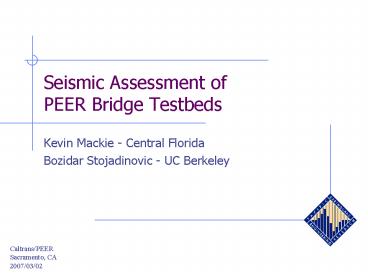Seismic Assessment of PEER Bridge Testbeds - PowerPoint PPT Presentation
1 / 20
Title:
Seismic Assessment of PEER Bridge Testbeds
Description:
Geotechnical: modeling, liquefaction, soil, piles, abutment, embankment. Bridge Configurations ... Abutment. PEER Methodology: Definitions ... – PowerPoint PPT presentation
Number of Views:108
Avg rating:3.0/5.0
Title: Seismic Assessment of PEER Bridge Testbeds
1
Seismic Assessment of PEER Bridge Testbeds
- Kevin Mackie - Central Florida
- Bozidar Stojadinovic - UC Berkeley
Caltrans/PEER Sacramento, CA 2007/03/02
2
Introduction Background
- Performance-based earthquake assessment
- Trend away from prescriptive approaches
- Performance metrics meaningful to engineers,
stakeholders, practitioners, owners alike
Multiple performance objectives
Confidence level of attain performance goal
Consequence-based engineering
3
Introduction Background
- Challenges
- Uncertain hazard
- Uncertain response (demand)
- Uncertain capacity (damage)
- Uncertain outcomes (loss)
4
Testbed Bridges
- Testbed bridges from Ketchum, Chang, and Shantz
Influence of design ground motion level on
highway bridge costs - Type 11 - 50 ft. column height
- Type 1 - 22 ft. column height
- Common prototype structure
- Structural modeling, performance-enhanced
elements, high-peformance materials - Geotechnical modeling, liquefaction, soil,
piles, abutment, embankment
5
Bridge Configurations
- Type 1 (22) and Type 11 (50) column height
- Different cross section options
Ketchum, Chang and Shantz (2004)
6
Bridge Model on good soil
Deck
- Modular analysis approach
- Fixed-based scenario
Column
Foundation
Abutment
7
PEER Methodology Definitions
- Divide the problem into pieces that can be
analyzed independently from each other - Intensity Measure ? IM
- PGA, Sa(T), PGV, etc.
- Engineering Demand Parameter ? EDP
- Column drift, fill settlement, etc.
- Damage Measure ? DM
- Cracking, spalling, buckling, etc.
- Decision Variable ? DV
- Repair cost ratio, downtime, etc.
- All variables are (can be) random
8
PEER Methodology Steps
- Define Performance Groups (PGs)
- Demand analysis
- Yields response (EDP) with uncertainty
- Damage analysis
- Yields damage state (DS) with uncertainty
- Loss analysis
- Yields material quantities (Q), repair costs
(RC), and/or downtimes (DT)
9
Define Performance Groups
10
Base bridge PGs
11
PEER Methodology Flowchart
- Intermediate probabilistic models for each PG
12
Damage and Repair Quantities
- Damage state definition for each PG
- Repair item quantity (Q) for each damage state
13
Decision Support
Unit Costs
Damage State (DS)
Total cost (TC)
Material quantity (Q)
Downtime (DT)
???
14
End product Repair Cost Ratio
- Total repair cost ratio vs. PGV for Type 1
15
End product Cost Fragility
- CDF of repair cost for Type 1A
16
End product Cost Sensitivity
- Contribution of each Q to expected total cost for
Type 11B
17
Expected costs for single hazard level
- Contribution of each Q to expected total cost
18
Missing pieces to puzzle
- Are there important PGs missing?
- Demand
- Are the EDPs selected consistent, computable, and
practical? - Damage
- Empirical, theoretical, experimental, or best
judgment recommendations for each PG damage
fragility - What repair methods correspond to DS and what
quantities?
19
Missing pieces to puzzle
- Loss/Cost
- Are there better sources of unit cost data?
- Are there missing repair materials and unit
costs? - Loss/Downtime
- Can downtime be correlated to material
quantities? - Inspection/reconnaissance/empirical sources of
downtime data?
20
Thank You!
- Testbeds and liquefaction-induced lateral
spreading - Christian Ledezma
- Bridge-specific contacts
- Kevin Mackie kmackie_at_mail.ucf.edu
- Boza Stojadinovic boza_at_ce.berkeley.edu
- John-Michael Wong jmwong_at_ce.berkeley.edu
This research was sponsored in part by NSF EERC
program grant EEC-9701568 as PEER Project 209/213































